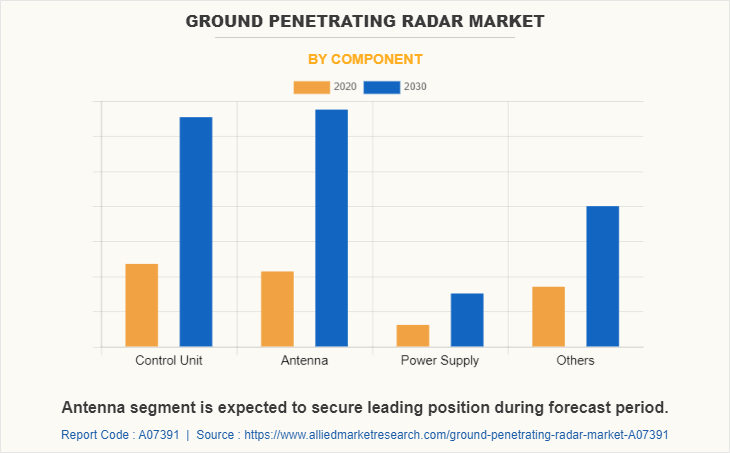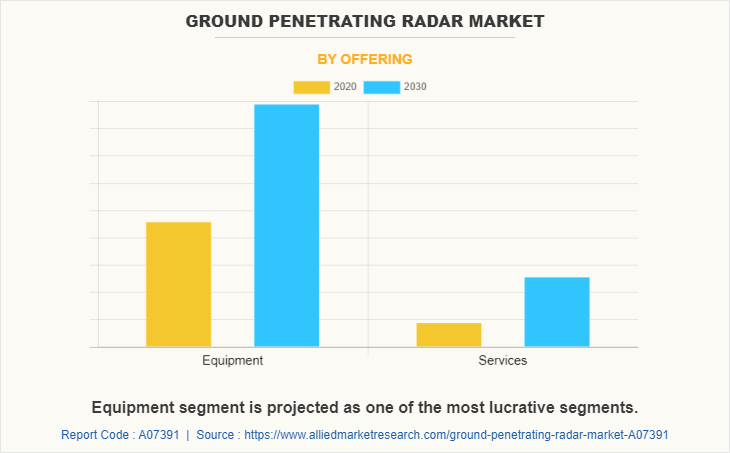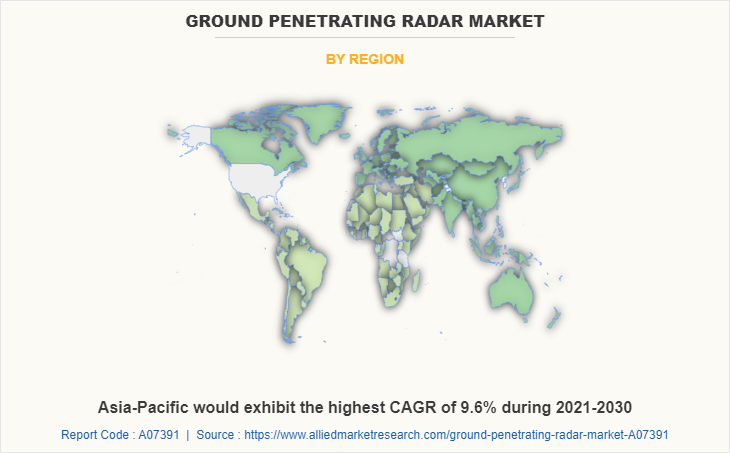Ground Penetrating Radar Market Research, 2030
The global ground penetrating radar market size was valued at $0.5 billion in 2020, and is projected to reach $1.1 billion by 2030, growing at a CAGR of 8.2% from 2021 to 2030.
Ground penetrating radar (GPR) is a geophysical technology for imaging below the surface of ground by using radar pulses. It is a nonintrusive approach of surveying the subsurface to look for metals, concrete, asphalt, pipes, and cables. This nondestructive method detects reflected signals from subsurface structures using electromagnetic (EM) radiation in the microwave frequency band (VHF/UHF frequencies) of the radio spectrum.

Growth of the global ground penetrating radar market is anticipated to be driven by factors such as benefit of GPR systems over other traditional technologies such as radiography and increase in concerns related to safety & protection of underground utilities. Moreover, surge in demand for GPR for a wide range of applications such as concrete investigation, transportation infrastructure, municipal inspection, disaster inspection, geology & environment, and archaeology fuels the market growth. However, lack of skilled workforce to operate GPR equipment acts as a major restraint of the market. On the contrary, modernization of existing infrastructure is expected to create lucrative opportunities for the ground penetrating radar industry.

Key Takeaways
The global market study covers 20 countries. The research includes a segment analysis of each country in terms of value for the projected period.
More than 1,500 product literatures, industry releases, annual reports, and other such documents of major market industry participants along with authentic industry journals, trade associations' releases, and government websites have been reviewed for generating high-value industry insights.
The study integrated high-quality data, professional opinions and analysis, and critical independent perspectives. The research approach is intended to provide a balanced view of global markets and to assist stakeholders in making educated decisions to achieve their most ambitious growth objectives.
Key Market Dynamics
Growth of the global GPR market is anticipated to be driven by factors such as benefit of GPR systems over other traditional technologies such as radiography and increase in concerns related to safety & protection of underground utilities. Moreover, surge in demand for GPR for a wide range of applications such as concrete investigation, transportation infrastructure, municipal inspection, disaster inspection, geology & environment, and archaeology fuels the ground penetrating radar market growth. However, lack of skilled workforce to operate GPR equipment acts as a major restraint of the market. On the contrary, modernization of existing infrastructure is expected to create lucrative opportunities for the ground penetrating radar industry.
Segment Overview:
The ground penetrating radar market is segmented into Component, Offering, Type and Application. By type, the market is classified into handheld systems, cart based systems, and vehicle mounted systems. On the basis of component, it is differentiated into control unit, antenna, power supply, and others. Depending on offering, it is divided into equipment and services. The applications covered in the study include utility detection, concrete investigation, transportation infrastructure, archaeology, and others.

Region wise, the ground penetrating radar market trends are analyzed across North America (U.S., Canada, and Mexico), Europe (UK, Germany, France, Italy, and rest of Europe), Asia-Pacific (China, Japan, India, South Korea, and rest of Asia-Pacific), and LAMEA (Latin America, the Middle East, and Africa). North America dominated the ground penetrating radar market in 2020, and is projected to register significant growth rate during the forecast period, owing to growth in the transportation infrastructure segment. However, Asia-Pacific is expected to witnesses significant growth by the end of the forecast period, followed by LAMEA.

The leading ground penetrating radar market manufacturers such as Geophysical Survey Systems Inc., IDS Georadar, and Leica Geosystems AG are focusing on their investments on technologically advanced, cost-effective, and more secure products and solutions for various applications.
Regional/Country Market Outlook
North America: The North American market is driven by increased adoption in infrastructure projects, utility detection, and environmental studies. The region benefits from strong technological advancements and government investments in smart cities and urban development, especially in the U.S. and Canada.
Europe: Europe has seen steady growth in the ground penetrating radar market due to rising applications in archaeology, transportation, and mining sectors. Countries like Germany, the UK, and France are key players, driven by a focus on infrastructure maintenance and heritage preservation.
Asia-Pacific: The APAC region is witnessing rapid growth due to increased construction activities and infrastructure developments in countries like China, India, and Japan. The demand is particularly strong in urban planning and geotechnical studies, making it a high-growth market.
LAMEA: In LAMEA, the market growth is moderate but expanding, especially in the Middle East where construction projects are booming. Additionally, the oil and gas industry in this region plays a significant role in driving GPR applications, particularly in underground utility detection.
Top Impacting Factors
The prominent factors that impact the ground penetrating radar market growth include increase in government support for deployment of GPRs and rise in concerns related to safety & protection of underground utilities. In addition, rise in demand for real-time GPR services fuels the market growth. However, high initial cost of ground penetrating radar products restricts the market growth. Conversely, high demand from Asia-Pacific is expected to create lucrative opportunities for the ground penetrating radarmarket.
Competitive analysis
Competitive analysis and profiles of the major ground penetrating radar market players such as Chemring Group, Geophysical Survey Systems Inc., Guideline Geo, Hilti, IDS Georadar, Leica Geosystems AG, Penetradar Corp., Radiodetection, Geoscanners, and Utsi Electronics Ltd. have been covered in the report.
Report Coverage & Deliverables
This report delivers in-depth insights into the ground penetrating radar market, by Component, Offering, Type, Application, and key strategies employed by major players. It offers detailed ground penetrating radar market forecasts and emerging trends.
Type Insights:
Handheld systems dominate due to their portability and ease of use in small-scale applications, while cart-based systems are preferred for larger areas like construction sites. Vehicle-mounted systems are gaining traction for transportation infrastructure and road condition surveys due to their efficiency over large distances.
Component Insights:
The antenna is a critical component driving GPR system performance, while the control unit integrates all data. Power supply advancements ensure long operation times in field applications. Other components, like software and sensors, support system accuracy and functionality.
Application Insights:
Utility detection leads the ground penetrating radar market due to its essential role in urban planning and construction. Concrete investigation is crucial for safety assessments in buildings, while transportation infrastructure applications are growing with the need for road maintenance. Archaeology sees steady usage for non-invasive historical site exploration.
Regional Insights:
North America leads in technological adoption for infrastructure and utility projects, while Europe focuses on archaeology and infrastructure maintenance. APAC is rapidly growing due to construction booms in developing nations, and LAMEA sees moderate growth driven by construction and oil & gas projects.
Key Strategies and Developments
In September 2021, Guideline Geo launched the MALA Easy Locator Core, the new industry standard for utility locating. The Easy Locator Core is the most effective utility GPR solution on the market! It has the highest quality, the best performance, and a slew of innovative new features.
In June 2024, Screening Eagle Technologies introduced the GS9000, a multichannel GPR system paired with a new app, designed to offer extensive benefits for professionals across various industries. The GS9000 is ideal for detecting buried pipes, ducts, and cables, ensuring safe digging and utility mapping. It also excels in structural diagnostics and monitoring of bridges, concrete structures, and roadways. Additionally, the system is valuable for geotechnical projects, aiding in the detection of geological anomalies and hazards.
In September 2023, IDS GeoRadar, a division of Hexagon, introduced the Chaser XR, a groundbreaking ground-penetrating radar (GPR) solution that sets a new benchmark in subsurface investigation with the longest inspection range available in a single device. Utilizing IDS GeoRadar’s innovative patented Equalised Scrambled Technology (EsT), the Chaser XR elevates GPR performance for geophysical surveying, delivering unmatched resolution and depth penetration.
Key Benefits of Stakeholders:
- This study comprises analytical depiction of the global ground penetrating radar market size along with current trends and future estimations to depict imminent investment pockets.
- The overall ground penetrating radar market analysis is determined to understand the profitable trends to gain a stronger foothold.
- The report presents information related to key drivers, restraints, and opportunities with a detailed impact analysis.
- The ground penetrating radar market forecast is quantitatively analyzed from 2020 to 2030 to benchmark the financial competency.
- The Porter’s five forces analysis illustrates the potency of the buyers and the ground penetrating radar market share of key vendors.
- The report includes the market trends and the market share of key vendors.
Ground Penetrating Radar Market Report Highlights
| Aspects | Details |
| By Component |
|
| By Offering |
|
| By Type |
|
| By Application |
|
| By Region |
|
| Key Market Players | ids georadar, Radiodetection, Chemring Group plc, Sensors and Software Inc., Guideline Geo, Hilti, Leica Geosystems AG, Utsi Electronics Ltd., Geophysical Survey Systems Inc., Penetradar Corp. |
Analyst Review
According to the insights of the CXOs of leading companies, the global ground penetrating radar (GPR) market is flourishing at a rapid pace. However, high initial cost of GPR products is still a concern for new entrants. Market players are generously investing in R&D activities to develop improved solutions to reduce the overall cost of GPR products. In addition, according to industry experts, it is essential to optimize affordable prices for GPR products for long-term growth.
In September 2021, Guideline Geo launched the MALA Easy Locator Core, the new industry standard for utility locating. The Easy Locator Core is the most effective utility GPR solution on the market! It has the highest quality, the best performance, and a slew of innovative new features.
Key players of the market focus on introducing technologically advanced products to remain competitive in the market. Partnership, acquisition, and product launches are expected to be the prominent strategies adopted by the market players. North America accounted for a major share of the market in 2020, owing to the presence of major players in the region; However, Asia-Pacific is expected to grow at the highest CAGR, owing to rise in adoption of GPR systems in a variety of fields.
The global ground penetrating radar market size was valued at $0.54 billion in 2020.
North America dominated the Ground Penetrating Radar market in 2020.
Geophysical Survey Systems Inc., IDS Georadar, and Leica Geosystems AG are the leading companies in Ground Penetrating Radar
Use of Ground Penetrating Radar in modernization of existing infrastructure is the latest trend.
Ground Penetrating Radar is widely used in a range of applications such as concrete investigation, transportation infrastructure, municipal inspection, disaster inspection, geology & environment, and archaeology.
Loading Table Of Content...


